A look inside the Student Innovation Center

Installation of the glass panels that will compose most of the Student Innovation Center's exterior walls will be done by March. White and purple material wrapping the lower portions of the building allow the interior to be heated while construction continues through the winter. Where the building is wrapped in white, glass will go. Metal panels will replace the purple areas. Photos by Amy Vinchattle.
It's more than a year from being finished, a busy hard-hat zone mostly bare on the inside as its glass exterior is pieced in place, but it still was exciting for the Student Innovation Center's new director to walk through the building that will be Iowa State's crown jewel for creating.
"To physically be here is really spectacular," said James Oliver, University Professor and Larry and Pam Pithan Professor of Mechanical Engineering, who as of Jan. 1 is the center's director.
Construction manager Leroy Brown and project manager Liz Clarke took Oliver and senior vice president and provost Jonathan Wickert on a tour of the center Jan. 9, showing off the progress made on the $84 million facility scheduled to open for the spring 2020 semester.
When completed, the Student Innovation Center will be the hands-on hub for students across campus, five floors (one below ground) full of places for making, designing, interacting and learning -- classrooms, student-organization spaces and co-working suites intermingled with fabrication labs, design studios and even a demonstration kitchen.
It'll be an unprecedented facility, said Oliver, who has been involved in steering committees planning the center's many uses. "There will be nothing else like it in the U.S., I think," he said.
Construction is a bit behind but still expected to wrap up on schedule, Clarke said. Installation of the massive floor-to-ceiling windows that will account for most of the 140,000 square foot building's exterior walls should be done by March. When that work is finished, the crane that's loomed over the site for more than a year will be gone, too, Brown said.
Here's a look inside the center:

Late afternoon sunlight bathes the west side of the Student Innovation Center's third and fourth floors, which look down on a second-floor courtyard accessible to the public. The panels interpersed in the glass surrounding the courtyard are whiteboards for indoor meeting spaces.

The entry level floor will feature a large staircase with built-in seating, which construction manager Leroy Brown called a "step-a-torium."
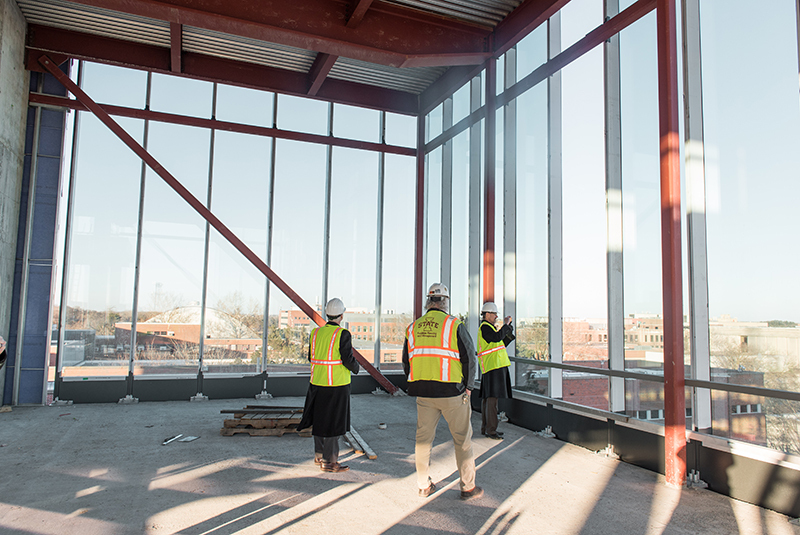
Senior vice president and provost Jonathan Wickert takes a photo in the northeast corner of the Student Innovation Center's fourth floor, where a multipurpose room is planned.
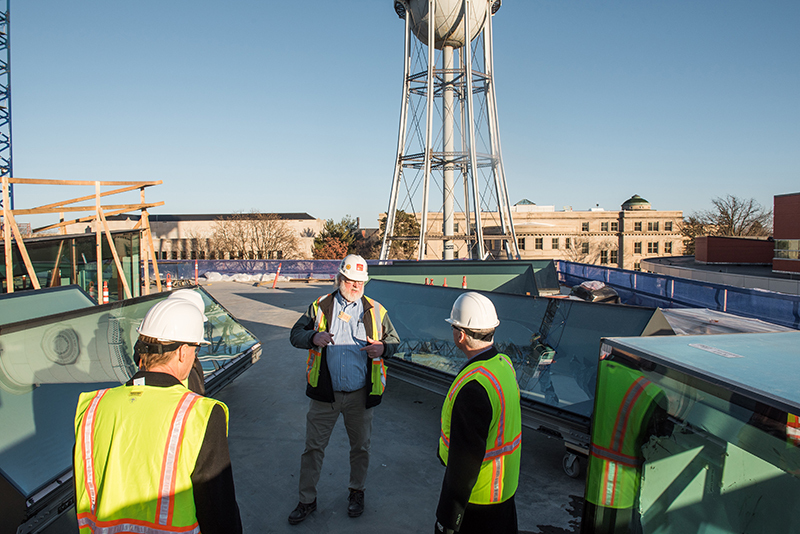
When the Student Innovation Center opens, a green roof of prairie grass will cover much of the third floor. For now, it's being used as a staging area for glass wall installation. Construction manager Leroy Brown (center) said keeping the panels there protects them against accidental damage.
ISU Extension listening, learning how to best serve Iowans
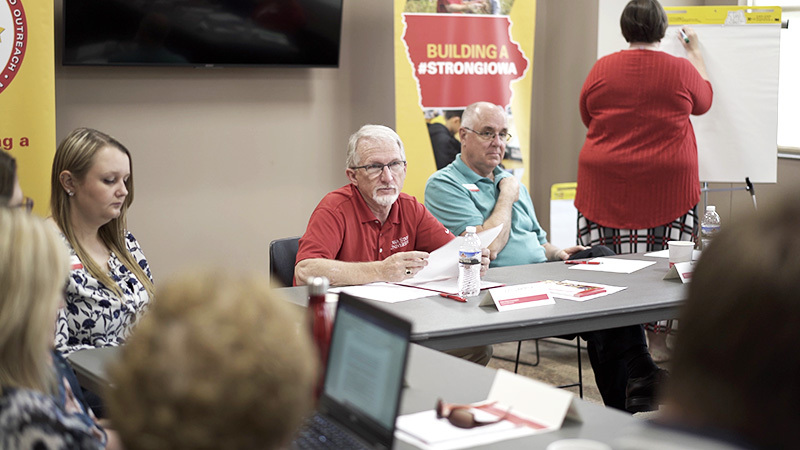
ISU Extension and Outreach vice president John Lawrence (center) listens during a meeting at the Mills County extension office in Malvern during his tour of all 20 regions of the state last year. Photo courtesy of ISU Extension and Outreach.
John Lawrence, vice president for ISU Extension and Outreach, did not waste any time getting to work when he assumed his responsibilities after serving in an interim role the previous year. Lawrence toured the state through a series of meetings to listen to issues and concerns and learn how extension can best serve Iowa.
Lawrence, who began his role as vice president last March, traveled over the summer and into October, with a total of 60 meetings, 1,200 people met and 4,000 miles traveled.
"It is not a new concept, but it had been a while since we had done a listening tour of sorts," Lawrence said. "This was a time to be intentional. We purposely invited people in, and not just whoever shows up, to take a snapshot of Iowa’s needs and where we are relative to their needs.
"So as we look forward, where should we be putting resources, how do we support our staff and are we doing the things that are valued by Iowans. If not, what kind of course corrections do we need to be thinking about?" he said.
Asking the right questions
Extension and outreach divides the state into 20 regions and Lawrence visited each. Three groups of people came to the meetings: stakeholders/partners, staff and representatives from extension and outreach councils.
The meetings centered around three questions:
- What are the top issues impacting the ability of this region to thrive?
- What do you need from extension and outreach to address those issues?
- Who else should extension and outreach be talking to?
Lawrence said workforce, housing, child care, mental health and the farm economy were near or at the top of issues at nearly every stop.
Starting at home
Communication within extension and outreach is an area Lawrence is out to improve. The division has approximately 890 full-time equivalent employees about 430 on the Iowa State campus and approximately 460 throughout the state.
"In an organization this size, invariably some people will hear things that others do not,” Lawrence said. "It raises questions about how best to communicate.”
An internal communications task force has been formed to address those issues, with recommendations expected in March.
There also is the issue of budgets, which include county, state and federal funds. Lawrence said because funding has been in decline for a couple of decades, there is concern about the impact on extension and outreach and what changes are necessary. He also learned not everyone is aware of everything extension and outreach does, so getting information to people in need is necessary.
Structured for success
In September, Lawrence appointed the Structured for Success committee to begin a yearlong process to study how extension and outreach is organized at the county, region and state levels. Trying to determine what successful counties are doing and how they are doing it is one aspect, as well as looking at how other states operate their extension service.
The 10-person committee includes Lawrence, assistant vice president for extension and outreach county services Bob Dodds, Iowa extension council association executive director Terry Maloy, three county directors, two county council members, a regional director and field specialist.
There are a variety of resources and budgetary constraints from county to county, but the goal of the committee is to recommend two to four organizational structures that could be used to help remedy issues and better serve Iowans.
"That will allow us to begin a discussion of 'Do you think your best situation is as you are organized now or would you like to try something different?'" Lawrence said. "If so, this is what the committee has learned and let's start a discussion about changing. It probably won't address everything at once, but with some of these things coming together later this year, we hope to experiment with some pilot projects. Organizational things like budget, communication, structure and how we most effectively address the needs of Iowans."
An example would be for county extension offices to pool their resources to improve service or have joint meetings instead of separate ones that attract few people.
A decade since last big changes
The last major change for local extension and outreach occurred in 2009 when the county director position -- Iowa State employees -- were eliminated and elected councils were given more responsibilities. With any action that may occur in the future, Lawrence wants to ensure it is as smooth as possible.
"We want to work on common problems, but act more like a team or more like a family," he said.
Welcome
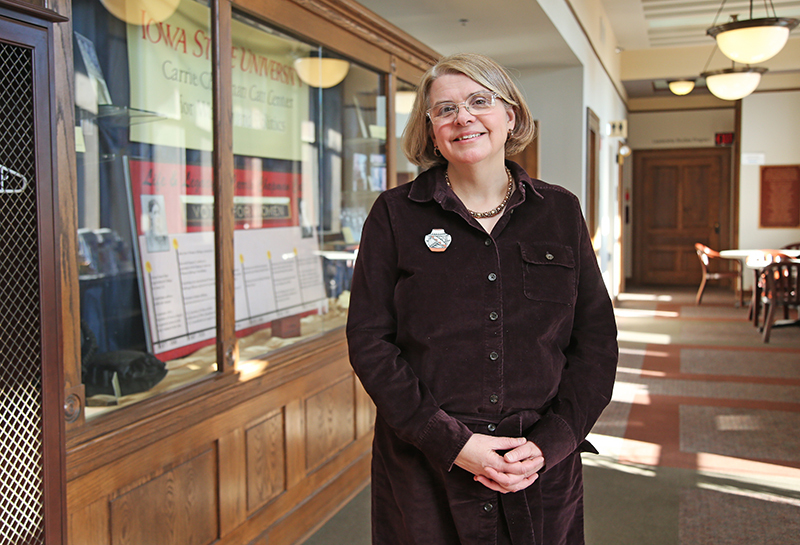
Karen Kedrowski is the new director of the Catt Center. Photo by Blake Lanser.
Karen Kedrowski, who was selected in a national search last summer to lead the Carrie Chapman Catt Center for Women and Politics, arrived on campus Jan. 2. She comes to Iowa State from Winthrop University in Rock Hill, South Carolina, where she served since August 2017 as executive director for its new Center for Civic Learning. She also was a professor of political science and co-director of the John C. West Forum on Politics and Policy, which trains future political and civic leaders through events and programming.
Kedrowski joined the Winthrop faculty in 1994. Her service there included other leadership roles, as dean of the College of Arts and Sciences (2013-17), chair of the political science department (2001-13) and director of the Office for Effective Teaching (1999-2001).
She earned a bachelor's degree from the University of Minnesota, Minneapolis, where she triple-majored in political science, French and history. She earned her master's and doctoral degrees in political science at the University of Oklahoma, Norman.
Kedrowski succeeds Dianne Bystrom, who retired in August after leading the Catt Center for 22 years. Her office is in 315 Catt Hall. She can be reached by phone at 294-4185, by email at karenmk1@iastate.edu.
Updated exit survey will expand to merit employees, retirees
A revamped exit survey for an expanded group of recipients should help university leaders -- and the Professional and Scientific Council -- better understand why staff leave Iowa State.
University human resources (UHR) in the past mailed an optional exit survey to P&S staff who left the university to take a job elsewhere. The response rate for the 220 to 250 surveys sent each year typically was about 30 percent, which is strong compared to industry averages, UHR benefits director Ed Holland told the P&S Council at its Jan. 3 meeting. But the survey has needed an update for years, he said. The questions didn't provide much useful information, and the data was difficult to access.
"There's been a lot of interest in changing that survey," Holland said.
The arrival of Workday, new software for managing university business processes that will go live July 1, was an impetus for making changes because it will enable automatic delivery of an online survey, Holland said. A workgroup met several times last year to discuss topics and methods, resulting in a survey of about 50 questions that aims to gather "actionable" data, he said.
"Everybody understands there's a cost to losing a valuable employee," said Jason McLatchie, who represented the council on the workgroup.
The anonymous and voluntary survey, hosted via third-party vendor Qualtrics, will ask departing employees about various aspects of their experience at Iowa State, including workplace culture, pay, benefits, work-life balance, supervision, and opportunities for training and development. It also will solicit information about why an employee is leaving, where he or she is going and demographics. UHR will share any apparent trends from the exit survey with department and college leaders, and a summary that avoids identifying personal responses will be collected in a report to be shared with the council, Holland said.
"We feel like we're going to get some good data," he said.
The survey strikes a balance between being thorough enough to be valuable but short enough to encourage participation, said McLatchie, a university library systems analyst. Participation also should increase because more staff -- merit employees and retirees -- will have a chance to take the survey. The survey won't be offered to staff who move to a different position at Iowa State.
Faculty responses to an exit survey are reported annually to the state Board of Regents, and the provost's office has found replies are more common if the survey is distributed when faculty are still on campus, said Brenda Behling, director of academic policy and personnel.
Once Workday goes live, a link to the survey will be included in the offboarding information departing staff automatically receive via the software platform, Holland said. Until then, beginning with employees who leave the university this month, a personalized link to the survey will be included in a letter mailed to them, he said.
Recommendations approved
In other business, the council unanimously approved its annual salary recommendation to university administration and a recommendation for overhauling the performance review process. The requests were first considered at the council's Dec. 6 meeting.
The council is advocating that P&S employees with satisfactory performance or better receive a pay increase between 3 and 5 percent for FY 2020, which begins July 1. The recommendation on performance evaluations suggests several steps to improve and standardize the process, including a new form and tracking system.
Oliver named director for Student Innovation Center
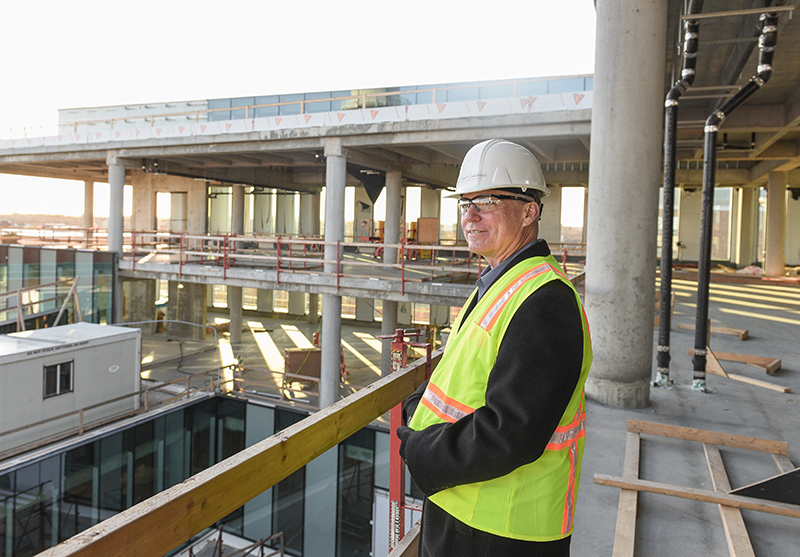
Student Innovation Center director Jim Oliver during a Jan. 9 tour of the construction site. Photo by Amy Vinchattle.
James Oliver has been named the first director of the Student Innovation Center. Oliver began the full-time appointment Jan. 1.
"Jim is a proven innovator in his teaching, research and technology transfer," said senior vice president and provost Jonathan Wickert. "He has built programs and relationships across campus -- exactly the culture that will be enhanced by the Student Innovation Center."
Oliver, University Professor and Larry and Pam Pithan Professor of Mechanical Engineering, has directed the Virtual Reality Applications Center since 2004, and the university's interdisciplinary graduate program in human computer interaction since 2003. Both programs combine faculty expertise in diverse areas such as psychology, biology, graphic design, architecture, English, computer science, music, engineering and education. Oliver also teaches a course on technology and global culture with the department of world languages and cultures.
"I look forward to the opportunity to lead this facility and the investment it represents in Iowa State's future," Oliver said. "The Student Innovation Center will foster innovation in teaching and learning, research and economic development, as well as outreach and community engagement."
Oliver earned a bachelor's degree from Union College, Schenectady, New York, and master's and doctoral degrees from Michigan State University, East Lansing, all in mechanical engineering. He held faculty roles at Michigan State and the State University of New York, Buffalo, before joining the Iowa State faculty in 1991.
In addition to his Iowa State responsibilities, Oliver cofounded BodyViz, a technology startup focused on low-cost, easy-to-use medical visualization with sales in the medical, education, veterinary and legal markets; and formerly headed product development for Engineering Animation Inc.
The Student Innovation Center, under construction on the west side of campus, will be completed in 2020. Oliver will provide overall leadership, vision and direction for the facility -- including planning and implementing academic programming -- and foster engagement among students and external stakeholders.
Related stories
- A look inside the Student Innovation Center, Jan. 10, 2019
- Faculty applicants sought for new facility director, July 19, 2018
- New building will be a student-centered collaboration zone, Jan. 12, 2017
Staff survey responses needed by Jan. 18
Want to know more?
FAQs for improved service delivery and ISD transition are available online. Questions can be submitted online or by email, ISD_transition@iastate.edu.
Yes. No. Maybe. All professional and scientific staff and merit employees are asked to respond with an answer to the online interest survey emailed Jan. 9.
The employee interest survey is the next step in filling finance and human resources specialist positions on 11 teams that power the improved service delivery (ISD) models introduced last fall. Qualified current staff will be considered for an estimated 180 specialist roles before public searches are opened.
Staff must respond "yes" or "maybe" no later than 5 p.m. Friday, Jan. 18, to be considered for a specialist role, and can withdraw from the process at any time. A "no" answer will end the survey and remove the employee from consideration.
By the numbers
More than 600 employees -- including many supervisors -- signed in at the Jan. 8 job showcase to learn more about the specialist positions in the human resources (HR) and finance ISD models. Recordings of the showcase presentations will be available on the ISD website later this week.
About 125 finance positions need to be filled, including three finance managers, up to four assistant finance managers and a roughly equal balance of specialists in finance, procurement and expense, and grants finance. Heather Paris, who last week was named associate vice president for finance and support services, will guide implementation of the ISD structure.
Associate vice president for human resources and strategy Dwaine Heppler will lead HR's ISD transition. The service teams will need about 55 HR specialists, including four senior HR partners. The bulk of the hires -- about 60 percent -- will be HR coordinators, followed by HR partners (30 percent) and staff recruiting specialists (10 percent).
Peters appointed Study Abroad Center director
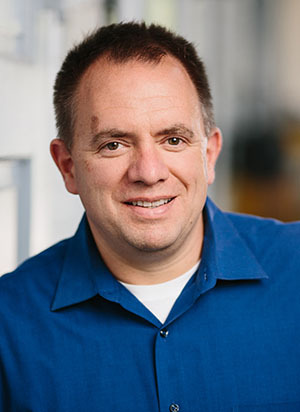
Frank Peters
Frank Peters, associate professor and C.G. "Turk" and Joyce A. Therkildsen Professor of industrial and manufacturing systems engineering, has been named director of the Study Abroad Center. Peters began his three-year, 75 percent appointment Jan. 2.
"Study abroad is a high-impact learning opportunity that helps students develop cultural competence and become more well-rounded global citizens," said Ann Marie VanDerZanden, associate provost for academic programs. "Frank will work with the colleges to develop and expand programs around the world, and help make study abroad accessible to every Iowa State student."
More than 1,800 students studied abroad in 55 countries during 2017-18. The Study Abroad Center assists students and faculty with program selection and preparation, as well as applying for passports and visas. This ensures the students' graduation is not delayed because of education abroad experience.
Peters, who joined Iowa State in 1996, holds bachelor's, master's and doctoral degrees in industrial engineering from Pennsylvania State University, State College. He has been involved in study abroad activities over the last two decades, including programs in England, Scotland and Ireland.
"I look forward to working with faculty, the Study Abroad Center staff, and study abroad staff in the colleges to more fully connect our programs to students' overall academic experiences," Peters said. "We want to enable students to integrate the experience of studying, traveling and living internationally with coursework that prepares them for successful careers and lives in a global environment."
VanDerZanden thanked Scott Grawe, associate dean for strategy and engagement in the Ivy College of Business, for his service as interim director since last January.
